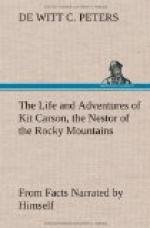villages, somewhat similar to the habits found in
civilized communities, for the passions and evil propensities
of all men are found to be alike, no matter what differences
of education or color exist. We find that the
Indian tribes have their wise men, whose voices are
heard and heeded on all occasions. When these
villages are located, or, to use soldier phrase; when
the Indians go into camp, care is taken that each
lodge shall be placed where it will not interfere
with the common good. The internal economy of
these habitations is arranged on a social system which,
in many respects, is commendable. When one person
is poor, generally speaking, the whole tribe is found
to be so. The herds of horses and mules belonging
to the tribe, are turned loose in one body as if they
were the property of one man. If game exists
in plenty and danger is not apprehended, happiness
holds complete sway within these Indian homes.
The proverbial caution of the red man rarely allows
him to be surprised; therefore, even in times of peace,
he keeps his fleetest horse tied at the door of his
lodge, so that he may make haste and collect his property,
and be away before his enemy can harm him. These
favorite animals are fed by hand. Before trusting
his body in sleep, some warrior, in whom the tribe
repose the utmost confidence, must ascend a neighboring
eminence, if there chance to be one, and examine the
country in search of dangers. Parties are always
kept out as spies, and, at the least appearance of
suspicious signs, they become easily aroused and vigilant,
and if danger really exists, word is immediately sent
to their village to be ready to move. This is
a homely but literal interpretation of the term Indian
village.
The reader has seen that the dragoon horses gave out
before the fatigues of the march, while the Mexican
ponies performed their tasks so admirably and easily.
This was a painful subject to contemplate and one
which no man who loves the noble horse could wish
to witness the second time. The dragoon horses,
reduced to skeletons from starvation while retaining
all their natural spirit, with tottering limbs, faithfully
tried to perform the labor which their riders, seemingly,
asked of them. Long before the arrival of the
time when they could no longer support a burden, the
soldiers had humanely relieved them from this work
and were assisting them, by all the means in their
power, to reach a haven of safety, where food, so
essential in restoring their sinking powers of life,
existed in abundance. As their little remaining
strength was leaving them, they would exhibit the
fact by staggering. Finally, breaking down in
their hinder legs, they would sink to the ground, but
not until they had made the effort to drag themselves
along with their fore feet. To relieve them from
their agonies and prevent their falling into the hands
of the Indians, one by one, they were shot.




